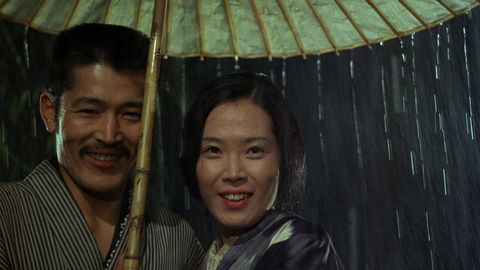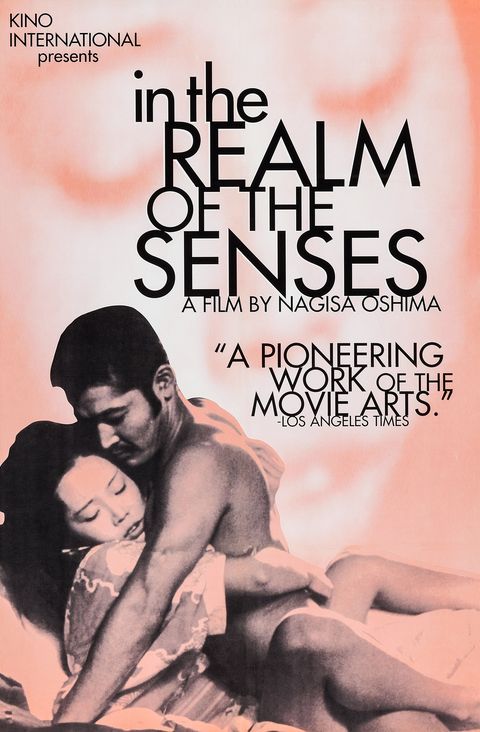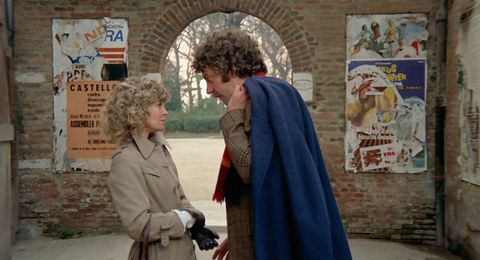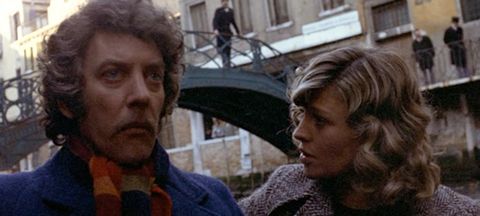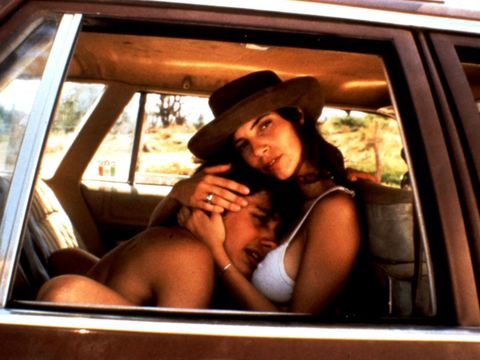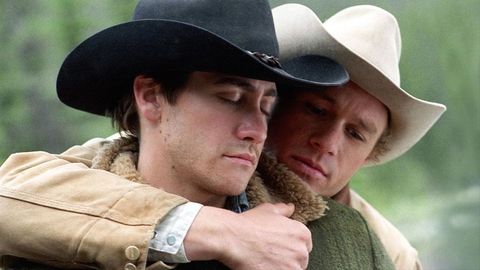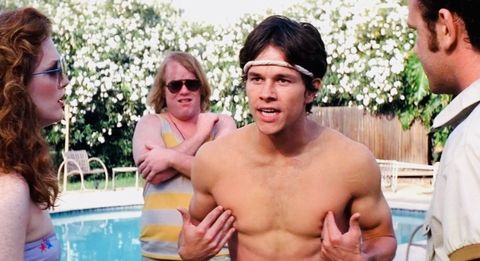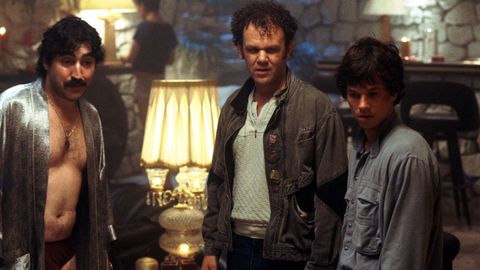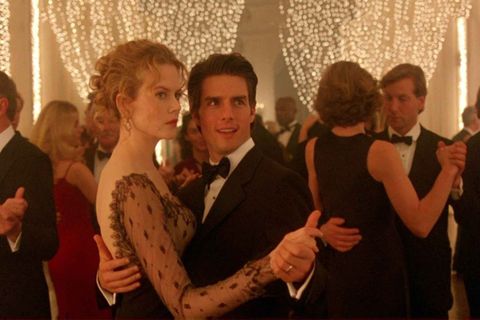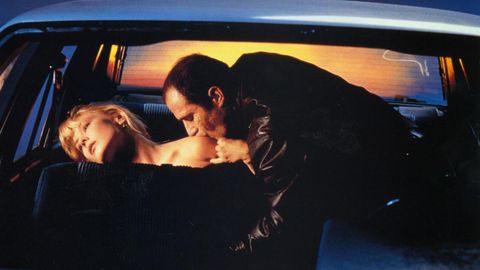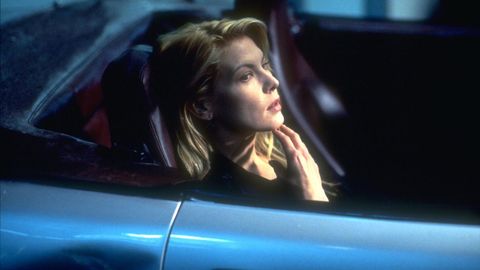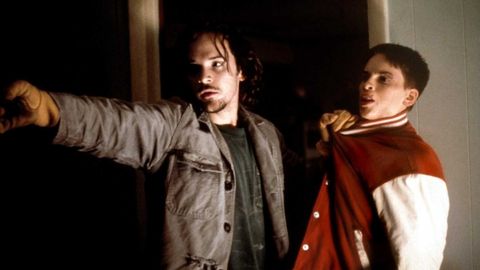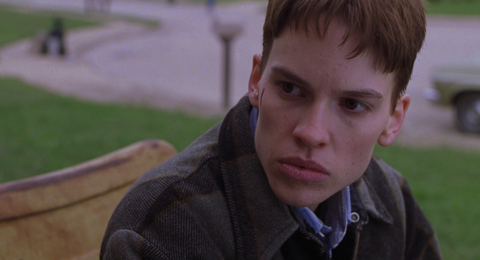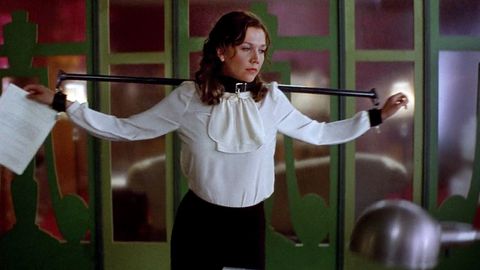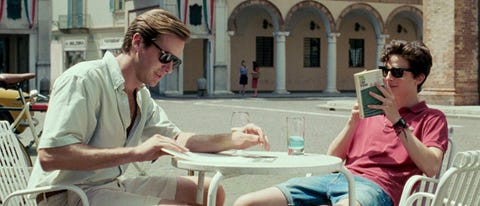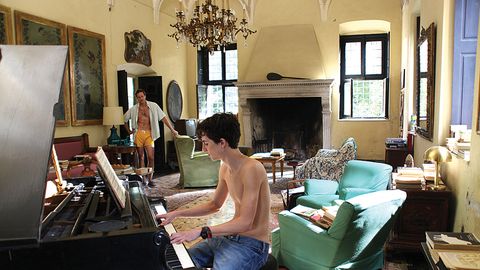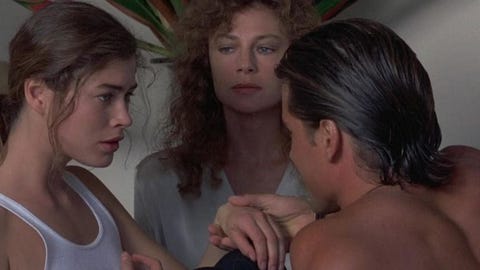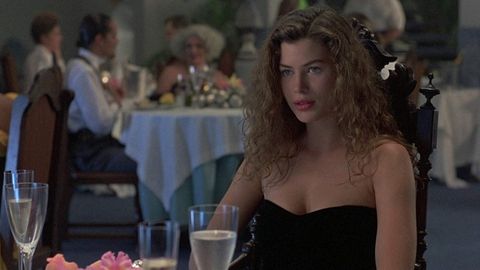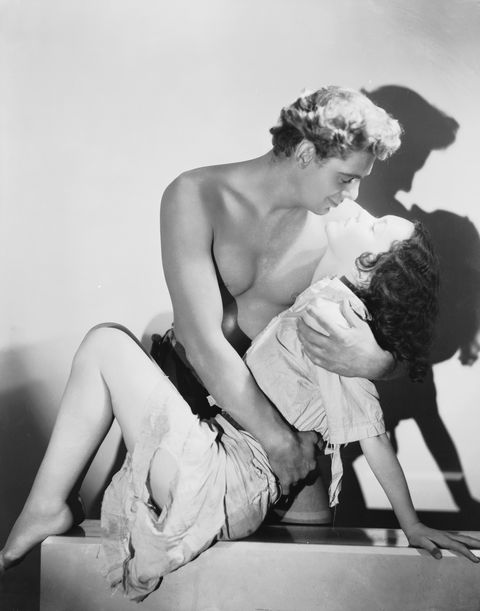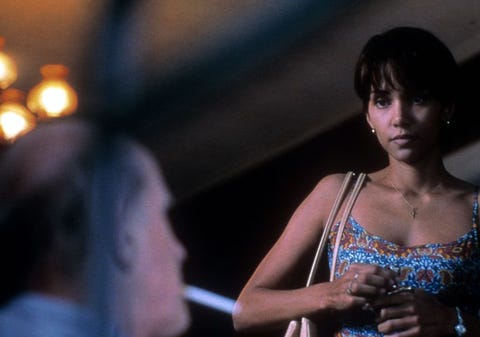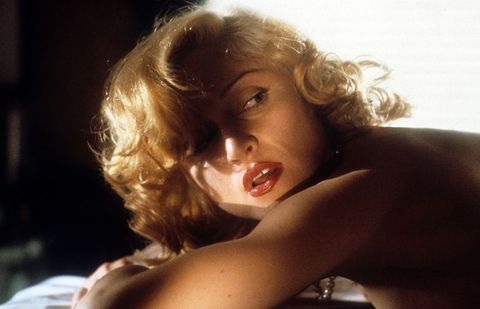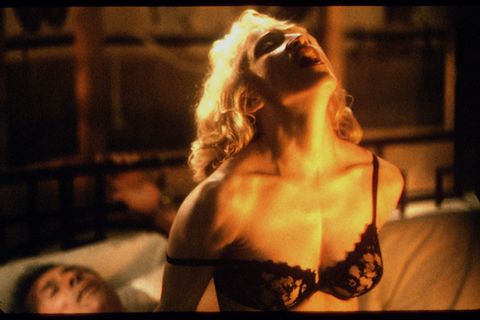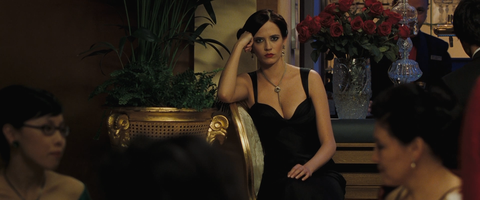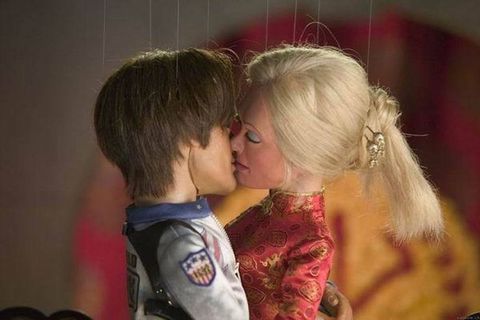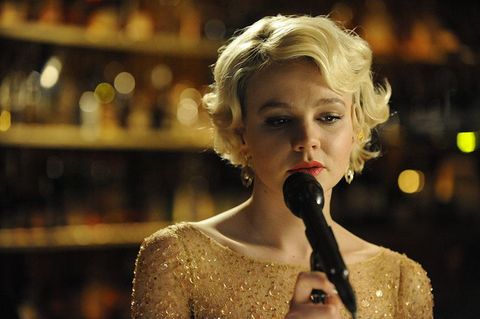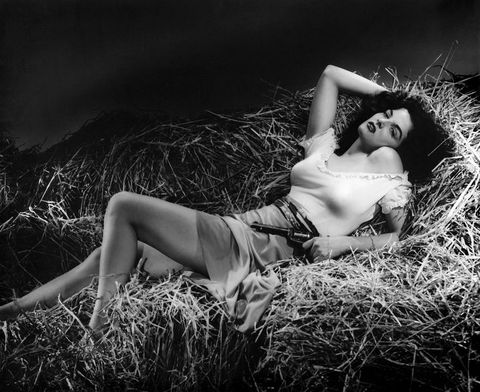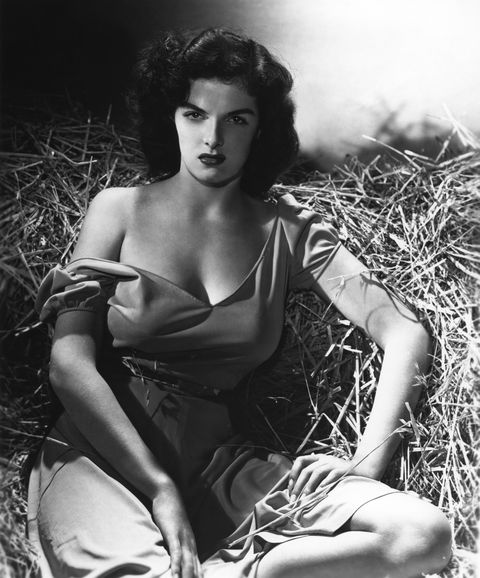Welcome to a countdown of the greatest sex films ever made about the small but preoccupying part of the human experience known as sex – from coming-of-age lesbian dramas to gritty portrayals of sex addiction to, erm, loincloths.
Put simply: these are the sex movies with the most to say about doing it, charting a history of how our attitudes towards sex and nudity on the big screen have shifted through the decades.
So get comfy – well, not too comfy – and enjoy.
In the Realm of the Senses (1976)
Nagisa Ōshima’s film about the increasingly violent love affair between a hotel maid and her boss in late-30s Tokyo depicts, in stark detail, pretty much every sex act you can imagine, plus plenty more you’d rather not. It courted controversy accordingly. The various bans and banishings are too numerous to list in full but highlights include the film being seized by US customs officials after screening at the NY film festival, a four-year court case for its director, on charges of obscenity and Portugal’s Archbishop of Braga registering his disgust by saying he “had learned more about sex in 10 minutes of the film than in his entire life”.
But explicit as it was, and notorious as it became, Oshima’s movie was not chasing cheap shocks. It’s graphic sex scenes were laying bare the gruesome destructiveness of the central pair’s relationship. And the matter-of-fact detachment with which it’s filmed gives the sex a weirdly ritualistic quality and the film a gradually more sinister tone as violence begins to encroach into the bedroom.
The period setting is not incidental. Pre-war Japan was not only politically tumultuous (world war loomed, there had been an attempted coup in February and the following year the country invaded China) but also a place of stern patriarchy and severe repression, and the bleakly violent logic that guides the lovers’ relationship is intended as a critique of the culture they exist within. In one scene Kichiko, the maid, is shown walking down the street while troops march by in the opposite direction. As sex and brutality become intertwined, and the affair becomes poisoned by intense possessiveness, the message is clear: society’s insidious cruelty will manifest itself everywhere, and not even the realm of the senses can provide an escape. Or as Oshima put it to the jury: “The sex is not obscene. What is obscene is what is hidden.”
– Alex Hess
WATCH HERE
Don’t Look Now (1973)
“We must not see humping. We must not see the rise and fall between thighs.” Such was the advice of the American film censors to Nicolas Roeg, director of the 1973 horror film Don’t Look Now, in response to a sex scene that would become one of the most famous – and infamous – in screen history.
The scene, between Julie Christie and Donald Sutherland, was a raw depiction of marital sex – with one of the few instances of cunnilingus in mainstream film – made all the more intense by the fact that the characters are grieving parents. Rumours have persisted that the sex was unsimulated, and although all parties strenuously deny any such claims, it’s easy to see why: it is starkly realistic. (On seeing the scene Warren Beatty, Christie’s then partner, flew to London to insist it was cut from the final edit.)
Roeg eventually appeased the censors by removing 0.3 seconds of footage and intercutting the sex with scenes of the couple getting dressed to go out afterwards (a technique that prefigured the great Clooney-Lopez love scene in Steven Soderbergh’s Out of Sight). But the scene remains famous – and rated as one of the best ever – not simply because of its alarming explicitness but because it broke a taboo few films ever venture near: the link between sex and death.
The film opens with the couple’s daughter tragically drowning, and the bedroom scene comes after the stricken couple have been approached by a supposed psychic who claims she can “see” the dead girl. The news, morbid as it may be, immediately energises a broken marriage.
It is of a piece with the film’s uncomfortable, psychologically interrogative tone that lust and grief, two seemingly opposite mental states, should be connected in this way and its the rawness of emotions, rather than simply the flesh on show, that gives the scene such weight.
Roeg said he wanted to make grief “the sole thrust of the film” – and he certainly succeeded in doing so, “thrust” being very much the operative word.
– Alex Hess
WATCH HERE
Y Tu Mama Tambien (2001)
The maniacal teenage libido has been a mainstay of cinema for some decades. Likewise the trials of adolescent friendship, and likewise the rebellious thrill of an impromptu road trip. But never have all those elements been combined to such remarkable poignancy as in Alfonso Cuaron’s timeless Mexican epic.
Y Tu Mama Tambien manages to have its cake and eat it on various fronts, packing in the poignancy of a coming-of-age film, the liberation of a road movie and the winning stupidity of a sex comedy, without compromising on any. Not to mention the undercurrent of razor-sharp commentary on Mexico’s rigidly tiered class system.
The film stars Gael Garcia Bernal and Diego Luna as goofy school-age buddies and from the opening shot, which shows one of our heroes frantically going at it with his girlfriend, it’s clear that fornication will play a central role in the next couple of hours. And so it does, the pair soon making friends with an enigmatic older woman at the races and regaling her with tales of an idyllic beach spot, which – metaphor alert – doesn’t actually exist. Before long the three have set off on a journey towards sun, sea and, yes, life-changing self-discovery.
The expected flings and fallouts do of course transpire, and the teenager boy’s sexual appetite is depicted in all it’s naive, clumsy, over-eager glory. Anyone who has seen American Pie, Superbad or Booksmart will know that the best teen sex comedies are actually platonic love stories in disguise. It’s part of the charm. Y Tu Mama Tambien is no different in that its purest romance is clearly between Bernal and Luna, but it does enter territory that those movies don’t by asking the question: just how platonic is this friendship really?
It’s a bold move and it is to the film’s credit that it offers no simple answers to the question, and the coda, in which the two meet up some months later, remains one of the most quietly emotive scenes of recent decades.
– Alex Hess
WATCH HERE
Brokeback Mountain (2005)
Brokeback Mountain was hardly the first ‘forbidden love’ story told by Hollywood. Nor was it the first gay love story. But it was arguably the first mainstream movie that forced America to confront its own ruinous homophobia.
Until Ang Lee’s film, homosexuality had been approached by mainstream film rarely and clumsily. When it wasn’t confined to outlandish comedy (The Birdcage) or quirky subplots (Dog Day Afternoon), it was looked at via a “big-issue” lens, and generally with a heartwarming conclusion (Philadelphia, The Color Purple). Brokeback Mountain took a different slant, casting Hollywood’s two best and most cherished young actors as a pair of on-off lovers forced by society into various states of repression, self-loathing and soul-destroying frustration. It also won establishment approval, with Lee taking home the best director gongs at the Oscars.
Crucially, the film made no bones about the fact that it was American society forcing this on them. Brokeback Mountain was set in the past, but not a past distant enough to be divorced from the present day. And besides, it wore its period setting lightly: bar the odd instance of disco-era fashion and dodgy décor, its frontiers setting meant it could easily be set in the contemporary US. As such, the gut-wrenching finale hit home doubly hard – likewise the scene in which Ledger’s character recalls the childhood memory being shown, by his dad, the mutilated body of a man killed in a homophobic attack.
It is ironic that Brokeback Mountain uses the frontier-land setting made famous by Hollywood movies, because the film’s heart couldn’t be any less Hollywood if it tried. Rather than delivering a love-conquers-all message (All That Heaven Allows), or a tale of noble sacrifice (Romeo and Juliet), or one where social taboos are conquered by goodwill and charisma (Shakespeare in Love, Dallas Buyers Club), Lee’s story had no redeeming sense of uplift, no cathartic payoff.
The ‘gay cowboys’ tag was always a red herring; Brokeback Mountain is clearly not a western. But in telling this particular story through the classic iconography of Hollywood’s favourite genre – horses, wide-brimmed hats, the sprawling plains of the Midwest – Lee pulled a neat trick: he made it clear that this was, unambiguously, a story about America.
– Alex Hess
WATCH HERE
Boogie Nights (1997)
In 1997, at roughly the same time pornographers were starting to wonder if this “internet” thing might affect their industry, Paul Thomas Anderson made a film about a similarly pivotal point in the sex-movie business. A film, aptly enough, that would help transform Hollywood.
Boogie Nights follows the porn business at the time when the films in question were moving from cinema to video: there is hope at the outset that a porno movie could be “artistic”; at the end, not so much. (If only it’s characters had lived to see the online age.) But beyond chronicling porn’s disco-era history, Boogie Nights achieved the seemingly impossible: it was a film about an X-rated industry – replete with corruption, drugs and semi-explicit sex – whose overriding tone was a kind of effervescent innocence. It also announced Anderson as part of the impossibly talented cool-kid crowd (along with David Fincher, Steven Soderbergh, David O Russell and Quentin Tarantino) that would go on to make the defining works of the next decade and beyond.
The instinct in making a film about porn would be to expose the misery and passionlessness behind the facade. Boogie Nights resisted the easy narrative in favour of a story about everyday people who meet at work, form bonds and surf the waves of a fast-changing industry with youthful cheer. Anderson’s film took us behind the scenes of the seediest industry possible, and showed us the innocence and humanity of the people in the middle of it and their commitment – like any filmmaker – to making a worthwhile movie.
Boogie Nights laid the groundwork for films and TV shows Lovelace or The Deuce, which both examined the porn industry of that era with an unsentimental eye. But it also helped inspire things like Mad Men and Halt and Catch Fire: ensemble portraits of a devoted, in-and-out-of-love workforce who are shooting for the stars while the industry changes under their feet. Porn, it turns out, is a business much like any other.
– Alex Hess
WATCH HERE
Eyes Wide Shut (1999)
It was the poster that did it. When Eyes Wide Shut was released in 1999, it was preceded by months of frenzied gossip. It was the first film in 12 years by Stanley Kubrick, the greatest living filmmaker, and it starred Hollywood’s golden couple, Tom Cruise and Nicole Kidman. And it was all about sex. Rumours had abounded over the spectacularly steamy sex scenes the central pair had shot together. One scene in particular, a masked orgy, had been the subject of much whispers – rumour had it Kubrick could barely get it past the ratings board. One magazine reported Kubrick hired sex therapists for the couple after they proved unable to act amorously with one another. And then, weeks before the release, Kubrick died suddenly.
The poster was a masterpiece of tantalisation: the surnames of its two stars and director printed above a shot of Cruise and Kidman locked in a raunchy coital embrace, Kidman glancing suspiciously at the camera. It promised everything you could want: sex, scandal, glamour and star power, overseen by a recently departed visionary. Low-trash repackaged as high art. Little surprise, then, that the film came out to mixed reviews and an underwhelming box office. Despite all the flesh on show, the film isn’t that steamy at all. In fact, like all of Kubrick’s movies, it’s cold and clinical to an almost robotic extent. It was about sex, just not in the way multiplex audiences were used to. This was sex not as pleasure but as manipulation, status, corruption, unease and distress.
In 2020, with our shock and smut thresholds having been transformed by the previous two decades, what endures about Eyes Wide Shut it not the explicitness of the sex (although it’s not exactly modest) but the unflinching way it deals with its characters’ tortured psyches.
The film is based on a novel written in Freud-era Vienna about the sexual odyssey of a doctor after his wife confesses to having fantasies about another man. Kubrick turned it into a chilly, lurid look at the psychosexual underbelly of American high society. The film recast Cruise, a hunky all-American golden boy, as charmless and sexually anguished, a man unable to get laid for love nor money, and the cavorting Kidman as brooding and unfulfilled. It was hard to escape the idea that the joke was on us. The real-life element to the casting – and the fact that Cruise and Kidman’s marriage spiralled out of control soon after the film’s release – added to the discomfiting idea that fact and fiction had been alarmingly blurred.
In a way, the lurid hype – and that poster – were the perfect precursor: the film is less about the reality of sex than the idea of it, and how what we expect to titillate us will often haunt and disturb instead.
– Alex Hess
WATCH HERE
Crash (1996)
David Cronenberg is a filmmaker with two fascinations. The first is the human body, specifically in a state of injury or mutilation. The second is the psychology of sexual power. None of his films combine the two more acutely than this 1998 adaptation of JG Ballard novel about a cult-like group of people who find themselves uncontrollably aroused by car accidents. An unorthodox premise, and one that in lesser hands would be an open invitation to make a taboo-breaking sex-and-gore shlockfest, a la Hostel or The Human Centipede. But Cronenberg’s genius was to take the story and its characters seriously – to play it fairly straight – and turn Ballard’s pulpy novel into a weird, detached but oddly profound film about the nature of thrill-seeking and the many ways human beings deal with trauma.
Which isn’t to say he forewent the sex and gore. He included enough of it, in fact, for two British newspapers to mount campaigns for the film to be banned: “Beyond the bounds of depravity” was the description in the Evening Standard, while the Daily Mail devoted a full front page to the cause (“Ban This Car Crash Sex Film” screamed the headline). As part of their response, the BBFC screened to a group of eleven disabled people and although they did not much enjoy the film, they concluded that “its depiction of disabled people as being able to be both sexually attractive and active, (despite rather than because of their injuries), was generally a positive thing”. The film passed uncut.
Once the dust settled, the consensus among the less reactionary critics was of a thoughtful, important film – Mark Kermode has called Crash “pretty much perfect” – and watching it now, perhaps the biggest shock is how moderate the whole thing is. What’s shown on screen is no more explicit that any number of films made before or since; instead it’s the film’s haunting tone that sticks in the mind. And by telling a story about peoples’ compulsion to become unduly excited by violence, it forces the audience to ask tricky questions of themselves, too.
WATCH HERE
– Alex Hess
Boys Don’t Cry (1999)
Bringing to screen the real-life story of doomed young runaway Brandon Teena, Boys Don’t Cry – along with Fight Club, American Beauty, The Talented Mr Ripley and In the Company of Men – was part of a spate of films that came out at the turn of the millennium to forensically examine what we would now call toxic masculinity (back then, the buzzphrase was “masculinity in crisis”).
But Boys Don’t Cry was different: it didn’t simply deal with the destructiveness of male rage but it did so by putting trans issues front and centre. The decision not to include any of the obvious terms – transgender, transsexual, gay, cross-dresser – in its script was a canny one, in that it freed the character of any narrowing labels and encouraged us to see him as a fully-rounded human, a young person struggling with amorphous identity issues. (The movie also showed up the enduring double standard of the censors: the film – which contained next to no nudity – was slapped with the notorious NC17 rating, downgraded only once Chloë Sevigny’s “too long” orgasm had taken a trim.)
Context is key: Seven years before Boys Don’t Cry was released, The Crying Game had treated the same topic as a shock-horror plot twist, while two years after that, Ace Ventura: Pet Detective repurposed the theme as a recurring punchline for derisive gross-out gags. This all came on top of cinema’s long history of depicting trans people as unhinged lunatics (Psycho, Dressed to Kill, The Silence of the Lambs). Boys Don’t Cry was not the first film to deal with trans issues but it was the first one to do so seriously and win mainstream plaudits in the process: Swank, a little-known TV actor, was soon receiving an Oscar for a role that earned her just $3,000.
In the 20 years since, trans characters have garnered one more Oscar win (Jared Leto for Dallas Buyers Club) and two more nominations (Eddie Redmayne for The Danish Girl and Felicity Huffman for Transamerica), while Yance Ford became the first transgender filmmaker nominated in 2018. Progress, slow as it may be, is afoot.
WATCH HERE
– Alex Hess
Secretary (2002)
Inevitably marketed as a titillating kink-fest, Steven Shainberg’s 2002 indie movie was in fact a smartly layered emotional drama – those viewers drawn in by the poster image of the stockinged legs and shapely posterior of a mysterious high heel-wearing seductress would get a bit of a shock.
Stockings, high heels and sexual adventurousness did indeed play a central part in Secretary’s plot, but more as a means of exploring the damaged psyches of its two main characters than arousing boyish excitement in its audience. The story follows Maggie Gyllenhall’s title character, a social outcaste and self-harmer, as she gets a job for – and promptly embarks on a relationship with – an attorney played by James Spader (who, having also starred in Sex, Lies and Videotape and Crash, has quietly amassed his own impressive oeuvre of thoughtful films about sexual compulsion). This is not your typical Hollywood romance though: rather than swooning and sweet nothings we get mousetraps, whips and an array of erotically-charged humiliations.
The pair’s burgeoning BDSM relationship is presented as unabashedly bizarre – and with no little humour – but also as heartfelt and sweet, a kind of therapy for the two emotionally stunted human beings who respectively harbour complexes about power, shame and transgression. With its weaving together of a workplace ardour and kink-laden bedroom antics, Secretary is a film with an obvious modern-day counterpart – Spader’s white-collar leather enthusiast is even called Mr Grey. Unlike its descendant, though, this is a movie whose real interest lies not in snatched glances of its character’s airbrushed flesh but in many the shades of dysfunction and intrigue that lie underneath.
Inspired by the way My Beautiful Laundrette had normalised gay relationships within mainstream cinema in the Eighties, Shainberg has said he was attempting to do something similar with fetishism. Or, as one character puts it: “Who’s to say that love needs to be soft and gentle?”
WATCH HERE
– Alex Hess
Call Me By Your Name (2017)
The first Hollywood film to feature a man being sexually pleasured with a hollowed-out peach? Almost certainly, although that’s not the only reason Luca Guadagnino’s luscious holiday romance made a splash when it came out in 2017. Tracing the tentatively developing relationship between an American teenager and the archaeology graduate who’s staying with the family during their sojourn to northern Italy, Call Me By Your Name is as much a film about mood and moments as it is about character or plot.
Coming-of-age romances on the big screen tend to be marked at some stage by trauma and tears but rather than the usual emotional-rollercoaster formula, we instead accompany Timothee Chalamet and Armie Hammer on a gentle summer-long bike ride through Moscazzano’s sunkissed vineyards and cobbled small-town streets, stopping occasionally for some freshly picked fruit or an impromptu handjob. The film is a sensual treat, so much so that you’re surprised to be reminded that the sex scenes themselves are infrequent and wholly inexplicit.
Crucially, though, the film treats our 17-year-old protagonist’s unexpected gay romance not as some urgent identity crisis but simply as a thrilling dalliance that he is swept along by, enjoys while it lasts and is left saddened when it ends. Just like any teenager’s holiday liaison, then. While Michael Stuhlbarg’s late monologue, in which he tells his son he enjoyed something similar back in his day and implores him to make the most of his youth, might be a bit on-the-nose for some, it certainly captures the unabashed sentiment and utter lack of cynicism that gives the film its charm. Tellingly, the director has rejected the idea that Call Me By Your Name is a ‘gay film’, arguing instead that “it is about the blossoming of love and desire, no matter where it comes from and toward what”.
WATCH HERE
– Alex Hess
Wild Orchid (1989)
Meet slick corporate titan James Wheeler (Mickey Rourke). He likes helicopters, cars, motorbikes, boardroom takeovers and having complete erotic control over submissive women. He was abused as a child, doesn’t like to be touched, and in almost every other way possible he articulates the character template for Fifty Shades of Grey‘s Christian Grey. He even speaks in that same halting, slightly sick-making, so-pervy-it’s-sexy (yeah, right) prose beloved of …Grey creator EL James.
For example, when out for a flirtatious stroll with potential conquest Emily (Carré Otis), Wheeler suddenly falls back and starts leering at Emily’s arse, Benny Hill-style. When she asks him what’s up, he simply smiles, super cool, half-winking at the boys in the audience, and sighs, “I just like watching you walk!” Wow, what a ladykiller!
And yet the eerie prescience of Wild Orchid is not what makes it great, or why it is one of the definitive moments in the history of movie sex. No, the film, written and directed by Zalman King, demands our attention because it is the literal, and chronological, highpoint of Eighties Hollywood erotica. Before it, 1986’s 9 ½ Weeks (which King also co-wrote and produced, with Rourke in the lead role as yet another pervy bully) and Fatal Attraction (1987) had marked the parameters for a genre that would speak of liberal sexual permissiveness but was actually about conservative sexual fear (AIDS, anyone?). But Wild Orchid topped them both. For with its lurid Latin setting (Wheeler is in Buenos Aires to buy a hotel, as you do), rampantly fornicating locals and the suggestion that, if you opened the window of your limousine you were likely to get hit by flying spunk, it had the edge on the competition.
Best of all, it boasts a closing sex scene (Wheeler and Emily in lotus, shot mostly from above, sparing no blushes) so protracted and explicit it troubled the censors (the film was originally rated X). It was shot to a $100m payday, and raised the great debate, not seen since Donald Sutherland and Julie Christie in Don’t Look Now (1973), that asks, “Were they or weren’t they? You know? Doing it for real?” In 2011, Otis finally addressed the issue, “Have you ever filmed a sex scene? Do you have any idea how many people were standing around? It was mortifying!” So, that’s a no then?
WATCH HERE
– Kevin Maher
Blue is the Warmest Colour (2013)
Art house movies. We get it. They do sex. That’s their thing. From Swedish nudes in 1953 (Summer with Monika) to the butter-based penetration of 1972 (Last Tango in Paris) to crazy irascible beach-side sessions in 1986 (Betty Blue), nothing screams “art house” more than a smartly directed and gamely acted sex scene. Then came Blue is the Warmest Colour.
The film, which won the Palme d’Or at the Cannes Film Festival in 2013, wiped away everything that had gone before it. The hideous rape of Monica Bellucci in Irreversible (2002)? The grimly determined humping from Japanese 1976 classic In the Realm of the Senses? All gone. Faded in comparison. Plus, it was gay sex. So it made the cutesy girl-on-girl action in Bound (2006) and Mulholland Drive (2001) seem dubious and cheap.
Instead, what it gave us was two young and relatively untested actresses, Léa Seydoux and Adèle Exarchopoulos, deftly describing, in the grim northern French town of Lille, the heady emotional rushes and sudden power shifts of an emerging relationship. Looks are exchanged, picnics are arranged, kisses are traded and then everything grinds to a halt at approximately one hour and 11 minutes into the movie, when director Kechiche and his two lead actresses deliver the type of jaw-to-the-floor sex scene that has subsequently raised the movie-sex bar to insane heights of verisimilitude and has pushed the literal definition of “simulated” to breaking point.
For here, over seven long breathy, sweaty, brightly-lit minutes, we run the unapologetic gamut of licking, sucking, squeezing, fingering, rimming, ramming, slamming, and general slithery, grindy, intercrural mayhem.
The scene has many detractors including the actresses themselves, who famously rounded on their director: Seydoux said making it was “horrible” and she would “never” work with Kechiche again. Once the film began sweeping up during the 2013 awards season, however, they recanted and said that they were “happy” with it. And yet, look at the scene now, within the movie, and away from the hype, and it doesn’t play too well. It’s crudely lit. It’s brazen, and yet also crass. And what it says, in its many nipple shots, arse close-ups, and vaginal teases, is that perhaps all sex scenes, no matter how well-intended, or how groundbreaking and profound, are inherently, well, kind of sleazy.
WATCH HERE
– Kevin Maher
Tarzan, the Ape Man (1981)
“I’ve never touched a man before!” It’s Bo Derek as Jane, kneeling over an unconscious Tarzan (Miles O’Keeffe) in their first screen encounter after 45 minutes of solo swimming, snake-dodging and needless knocker action on behalf of Jane and her lovingly photographed breasts (photographed, I might add, by director-husband John Derek, so that’s OK). Tarzan is lying on the sand in his trademark loincloth and, oddly, a funky headband. Undeterred by the outfit, Jane starts touching. “It’s nice,” she says, going slowly, yet directly, for the crotch. “It’s very nice!”
Tarzan, clearly uncomfortable with the whole date-rapey vibe, leaps back into action dragging the movie through a series of strange, breast-based set-pieces that climax in a quirky “native jungle village” (actual location: Sri Lanka). The film, of course, is genius. No, really. Because it parlayed over 20 years of Russ Meyer sexploitation flicks (see Faster, Pussycat! Kill! Kill!, 1965), and so-called “Nudie Cutie” stag films into a mainstream, studio-financed, money-making event.
And what an event! There was a much-hyped lawsuit from Tarzan creator Edgar Rice Burroughs’ estate, orders for nudity cuts from the studio, and publicised cries of “censorship!” from director Derek.
The film, which cost about $6m to make, made $37m at the box office (equivalent to a blockbuster like The Dark Knight today taking more than a billion dollars) and proved that in mainstream cinema the rubric established 40 years previously by Jane Russell in The Outlaw (see # 1) still held true, and was more relevant than ever, namely: tits sell.
WATCH HERE
– Kevin Maher
Monster’s Ball (2001)
Something happened with sex scenes around the millennium. They went from being slightly tawdry (Angel Heart, 1987), titillating (Risky Business, 1983) and tacky (Porky’s, 1982) to dramatically satisfying and, ultimately, Oscar-worthy. Kate Winslet in 2008’s The Reader (Nazi sex), Charlize Theron in 2003’s Monster (serial killer lesbian sex), Michelle Williams in 2010’s Blue Valentine (Gosling sex), and Maria Bello in A History of Violence (2005) got a Golden Globe nomination for dress-up as a cheerleader then a bit-of-rough-on-the-stairs sex.
Nowhere is the switch more evident than in Monster’s Ball, where former B-list actress Halle Berry snagged the Best Actress Oscar partially because of the “bravery” she displayed during the terrifying sex scene. “Terrifying” because Berry’s playing the date-from-hell against Billy Bob Thornton’s straight man. He’s a prison guard who meets her in a diner. She’s grieving for her dead son. He takes her home. They drink whiskey. She starts blubbing. Thornton puts a nervous hand on her shoulder. “Er, I’m not sure what you want me to do?” he says, tentatively. Then, wham, she pulls down her top and starts chanting, “Make me feel good! Can you make me feel good?”
Naturally, he goes for it (good man, Billy Bob!), but you just know that he’s keeping one eye open, in case she tries to clatter him across the back of the head. Thus follows five minutes of raw therapeutic ramming, artfully intercut with close-ups of hands freeing a birdie from its cage (hang on! I think I get this metaphor! Give me a second! Is it to do with freedom?). Director Forster said: “When I spoke to Billy Bob and Halle, I told them it was important that these two emotionally repressed characters start the sex scene raw and animalistic. They express everything that has been repressed for years.” Of course, we all totally got that. So did the Oscar voters.
WATCH HERE
– Kevin Maher
Body of Evidence (1993)
I met Willem Dafoe recently and I asked him about Body of Evidence. The film, in which he stars as a lawyer in rainy Portland, Oregon, defending a part-time gallery owner and full-time dominatrix (Madonna) charged with murder-by-vagina, is generally derided as a giggle-inducing, all-time cinematic low. Perhaps typically, or not, Dafoe had much to defend in the film. He liked playing the bitch to Madonna’s butch. He was disappointed with the marketing hype that revolved around Madonna’s nudity. And mostly, he felt that Madonna became an unhelpful “symbol” for the bad buzz around the film.
“The timing was wrong, and it got presented the wrong way,” he said. “Because it was essentially an old-fashioned courtroom movie, which I got a kick out of, where I’m almost like the woman’s role and she’s the man. And in the end, it was one of those cases where the symbol of the movie began to matter more than what the movie actually was, even for those people who hadn’t seen it.”
And certainly, re-watched today, Body of Evidence is not any more preposterous or poorly acted than, say, Sea of Love (1989), Basic Instinct (1992), Sliver (1993), Disclosure (1994), or any one of the vapid, push-button Hollywood flesh-fests that came before or after it (although you possibly haven’t lived until you’ve seen Madonna square up to Dafoe and hiss, “Have you ever seen animals make love, Frank? It’s intense!”). And neither is its depiction of straight-faced, lip-quivering S&M rituals (melted wax on cock, broken bulbs in back) any more absurd than those enacted by Charlotte Rampling in The Night Porter, Juliette Binoche in Damage (1992) or Emmanuelle Seigner in Bitter Moon. Instead, what remains in Body of Evidence, and very much so, is a profound sense of the ridiculous (“That’s what I do, Frank. I fuck!” says Madonna at the film’s climax).
It proves something common to all S&M movies, and all films that take sex very seriously indeed (yes, that means you, Fifty Shades of Grey), is that, sometimes, it behooves all film-makers to be aware that sex is also, in its essence, never without humour (see # 3).
WATCH HERE
– Kevin Maher
Kids (1995)
Kids is pretty much in its own category. For the questionably voyeuristic child-sex genre is, thankfully, a limited business, and mostly limited to the films of Larry Clark – see also Bully (2001), Ken Park (2002) and Wassup Rockers (2005). It doesn’t help that, with Kids – a day in the life of teenage New York skaters, dossers, drinkers, stoners and shaggers – Clark shoots his subjects via a “documentary” style that borders on creepy cinematic stalking, where every lifted limb is captured, every naked profile, every panty flash noted. Neither is the subject matter going to win him any friends (Kids got a commercially damaging NC-17 rating [no children under 17] on release), especially when the film opens with odious 17-year-old protagonist Telly (Leo Fitzpatrick), a self-described “Virgin Surgeon”, deflowering a doe-eyed 12-year-old girl, and closes with Telly’s teen buddy Casper (Justin Pierce), raping stoned acquaintance Jennie (Chloë Sevigny), in her sleep.
And yet. It’s hard to dismiss Kids. And there’s certainly a sense that the cinematic world is a more complex and intellectually rigorous place because of its existence. Listen, for instance, to Clark himself questioning the validity of the film’s NC-17 rating. “Maybe it’s because Kids is not some fantasy bullshit. And every fucking movie now, has this sex scene in it, you know the guy’s laying on his back and the girl’s wiggling on top of him, he’s got her breasts, and it’s this stylised fake shit. But they’re not NC-17.
“I just saw that movie Clueless [1995]. Everything in that movie is in my film. It’s about a teenage girl who’s looking to lose her virginity. There’s pot-smoking and drinking, and a scene where she walks out of a party and she’s stepping over bodies and people are throwing up in the swimming pool. It’s a lot of the same stuff that’s in Kids, but it’s done in the stupidest way, and everyone just finds it so fucking funny because it’s so cute. Nobody puts that movie up to the standards that they’re putting me up to. People say they find Kids depressing. I find something as fake as Clueless depressing.”
And the man, as they say, has a point.
– Kevin Maher
Casino Royale (2006)
Stay with me. Yes. Casino Royale. Think about it. The greatest sublimated sex scene in film history. Better than the train into the tunnel in North by Northwest (1959). Better than the chess game in The Thomas Crown Affair (1968). Instead, it’s Bond (Daniel Craig), barely conscious and dragged into the rusty bowels of a moored torture tanker. Naked and bound, 007 is rammed into a seatless chair, forcing his balls to poke through.
Le Chiffre (Mads Mikkelsen), a terrorist financier desperate to recover his cash, repeatedly thwacks Bond’s bollocks with a pendulous rope while gurgling sweet nothings, “Wow! You’ve taken good care of your body!” And yes, we’ve been here before. Goldfinger (Gert Fröbe) had certainly put some thought into laser-beaming the crotch of Bond (Sean Connery) in 1964. But this is different. It is making explicit all that was implicit, all those years, in the Bond legend. All that babe-bedding.
The defining antagonistic relationships with male villains versus the trifling female flings. Here it is, finally, in Casino Royale. It is homoerotica writ large. An S&M torture scene that wouldn’t be out of place in Fifty Shades. Control and submission. Le Chiffre gets his man. And Bond gets his rocks (almost literally) whacked off.
Ultimately, the scene worked so well, in opening up the gay world of Bond, that it was revisited in Skyfall (2012), when Bond is tied to a chair once more by enemy Raoul Silva (Javier Bardem), who purrs, “First time for everything.” To which Bond smirks and replies, “What makes you think this is my first time?” Silva gasps, “Oh, Mr Bond!” Quite.
WATCH HERE
– Kevin Maher
Team America: World Police (2004)
Sex is funny. We know this. Everyone who’s ever done it knows this. Everyone who’s ever said something really fucking stupid while they were fucking and then burst out laughing afterwards knows this. Movies, however? Not so well clued in. And the worst of them, and the ones that fall flattest on their faces, are the ones that box out completely even the tiniest possibility of humour. Sharon Stone and Billy Baldwin, ramming themselves repeatedly and energetically against a concrete pillar in Sliver is one of them (they’re physiologically nowhere near coitus – unless his penis is penetrating her, through her black dress, somewhere above the fifth lumbar vertebrae). Most of Basic Instinct is another (“Have you ever fucked on cocaine, Nick?” No, it’s mostly ale and kebabs, Shazzer), and all of Showgirls (1995). And no, contrary to received critical wisdom, Showgirls was never meant to be funny, camp or kitsch. Director Paul Verhoeven has always claimed it was intended to be, and still is, a “beautifully shot, and elegant” movie.
So, thank God for Team America: World Police. The puppet-based action blockbuster arrived just in time, in 2004, when the movie world was still debating the issues of extreme sex in Irreversible, real sex in 9 Songs and Oscar-winning sex in Monster’s Ball. Team America shat on that. Literally (the uncut centrepiece sex scene includes an extreme act of scatological humour). And you always knew that a sex scene was going to be special if it began with the lines, “The gorillas beat him to death before the zookeepers could gas them all. My acting got my brother killed, and I have to live with that every day.”
The actor is Gary (director Parker), and the lover is ace psychologist Lisa (Kristen Miller). The sex scene that follows is 70 screen seconds of unadulterated, heart-warming lunacy that makes the possibility of future straight-faced sex scenes very tricky indeed. For it’s all there. The fingers down the six-pack, the profile copulation with open windows and billowing curtains. The hair rock soundtrack (an Aerosmith knock-off called “Only a Woman”). And the increasingly ridiculous and giggle-inducing positions (more so, obviously, because of the puppet protagonists).
It’s perhaps no coincidence the slick Hollywood sex scene almost entirely disappeared after Team America, and that within two years the populist comedies that emerged from Tinseltown were the comedies of Bromance (The 40 Year-Old Virgin, Knocked Up, Superbad etc): all films that established as their fundamental subject the inherent humour of sex and sexual desire.
WATCH HERE
– Kevin Maher
Shame (2011)
Shame is the moment when everything collides. The art house, the S&M flick, the Oscar-worthy sex scene, the mainstream marketing hype. It’s all there in Shame, a dark and grimly compelling tale of one man’s increasingly insatiable appetite for both sexual fulfilment and emotional annihilation. And yes, as directed by Steve McQueen and performed by Michael Fassbender, the movie is conspicuously low on laughter. And there is, undoubtedly, a flipside Shame that lives in an alternate movie universe, and it’s called The Shagger, and features the exact same characters, plot and location, but is shot mostly in daylight, with KT Tunstall playing on the soundtrack, and starring Ben Stiller. And it’s pretty funny.
But Shame is more than that. It’s a sombre, serious film that reaches and eaches for greatness, and tries, and hopes, to speak about the dominant and oppressive sexualisation of the culture we live in today. It pitches Fassbender’s anti-hero, Brandon, through a series of contemporary sexual scenarios – from the benign (internet porn) to the slightly, well, eccentric (fetishistic gay bar followed by a threesome with prostitutes) – and watches him crumble to nothing when faced with the seemingly simplest of sexual tasks, namely, to experience a physical encounter with a woman he likes, and indeed might love. Tragic.
It helped too, for the hype around Shame (the film was given the dreaded NC-17 rating, which it didn’t challenge and instead celebrated) that star Fassbender was perceived at the time (and possibly still is) as something of a man about town. An absence of long-term relationships in his past, plus a string of ex-girlfriends, plus a legal barring order from one of them (actress Sunawin Andrews), all pointed surely towards Brandon-esque tendencies in this white hot star?
I asked him about this when I met him, about the interplay between Brandon and Fassbender, and this is what he said. “People don’t know me. But when you don’t have some socially acceptable normative behaviour, where you’re not married at a certain point in your life, people are always going to fill in the blanks. Was Brandon a performance that was relating to me, or cathartic to me? It’s like, whatever! I brought my contribution to it, Steve did his thing, everyone involved did their bit. It’s out of my hands from then on in. I know what my personal life is, and thank God I’m not going through the imprisonment that is Brandon’s life.”
WATCH HERE
– Kevin Maher
The Outlaw (1943)
Because it had to start somewhere. And no, I’m not talking about flashing thighs in Busby Berkeley numbers, or Claudette Colbert’s leg in It Happened One Night (1934) or Fay Wray almost topless in King Kong (1933). Instead, The Outlaw is the movie, more than any other, where the decadent and often leery subtext of Hollywood product (what is King Kong, other than an interracial sex fantasy?) comes spilling out over the surface, and encapsulates the entire project.
The Basic Instinct of its day, the Shame, this movie, under the fetishistic gaze of millionaire director Hughes, pretended to be about Billy the Kid (Jack Buetel, a miserable actor) and Doc Holliday (Walter Huston, bored), but was really about the misadventures of feisty sidekick Rio McDonald (Jane Russell). The latter, then a young starlet known only for her impressive embonpoint, was the focus of everything about the movie, from breast-obsessed camera shots, to the marketing campaign itself. “What are the two reasons for Jane Russell’s rise to stardom?” screamed the film’s smutty, and frankly naff, tagline.
For its sins, the movie, which finished shooting in 1941, remained in distribution limbo for five years, bouncing from film company to censors’ scissors, to public decency campaign, back to film company, to brief 1943 release, to limbo again, and eventually becoming a smash hit in 1946.
Ultimately, The Outlaw’s raison d’etre, as no doubt Howard Hughes would have told you, is the depiction of Russell, who appears after 21 minutes of screen time, covered to the neck in a modest black top, and will spend each successive appearance on camera in lower and lower cut tops, in more and more lascivious poses, until finally, gagged and bound at a desert watering hole, she is splayed entirely, passively, for the (male) audience’s delectation, arms aloft and body beautifully lit by one of the greatest cinematographers the medium has known, Gregg Toland (Citizen Kane (1941), The Grapes of Wrath (1940) etc etc). For The Outlaw, in its chromosomal essence, is the first time a complete film said nothing at all to the watching, leering, male audience, other than, “Fuck me!” The rest is history.
WATCH HERE
– Kevin Maher
This content is created and maintained by a third party, and imported onto this page to help users provide their email addresses. You may be able to find more information about this and similar content at piano.io

